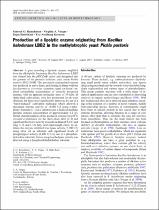 ResearchSpace
ResearchSpace
Production of a lipolytic enzyme originating from Bacillus halodurans LBB2 in the methylogrophic yeast Pichia pastoria
JavaScript is disabled for your browser. Some features of this site may not work without it.
- ResearchSpace
- →
- Research Publications/Outputs
- →
- Journal Articles
- →
- View Item
| dc.contributor.author |
Ramchuran, Santosh O

|
|
| dc.date.accessioned | 2007-06-29T06:17:15Z | |
| dc.date.available | 2007-06-29T06:17:15Z | |
| dc.date.issued | 2006-07 | |
| dc.identifier.citation | Ramchuran, SO. 2006. Production of a lipolytic enzyme originating from Bacillus halodurans LBB2 in the methylogrophic yeast Pichia pastoria. Applied Microbiology and Biotechnology, Vol. 71(4), pp 463-472 | en |
| dc.identifier.issn | 0175-7598 | |
| dc.identifier.uri | http://hdl.handle.net/10204/731 | |
| dc.description | Article published in Applied Microbiology and Biotechnology 71(4):463-72 | en |
| dc.description.abstract | A gene encoding a lipolytic enzyme amplified from the alkaliphilic bacterium Bacillus halodurans LBB2 was cloned into the pPICZaB vector and integrated into the genome of the protease deficient yeast strain Pichia pastoris SMD1168H. This previously undescribed enzyme was produced in active form, and cloning in frame with the Saccharomyces cerevisiae secretion signal (a-factor) enabled extracellular accumulation of correctly processed enzyme, with an apparent molecular mass of 30 kDa. In shake-flask cultivations, very low production levels were obtained, but these were significantly improved by use of a “batch-induced” cultivation technique which allowed a maximum enzyme activity of 14,000 U/l using p-nitrophenyl butyrate (C-4) as a substrate and a final extracellular lipolytic enzyme concentration of approximately 0.2 g/l. Partial characterization of the produced enzyme (at pH 9) revealed a preference for the short-chain ester (C-4) and significant but lower activity towards medium (C5-C6) and long (C16 and C18) fatty acid chain-length esters. In addition, the enzyme exhibited true lipase activity (7,300 U/l) using olive oil as substrate and significant levels of phospholipase activity (6,400 U/l) by use of a phosphatidylcholine substrate, but no lysophospholipase activity was detected using a lysophosphatidylcholine substrate. | en |
| dc.language.iso | en | en |
| dc.publisher | Springer | en |
| dc.subject | Lipolytic enzyme | en |
| dc.subject | Bacillus halodurans | en |
| dc.subject | Saccharomyces cerevisiae | en |
| dc.subject | Lysophosphatidylcholine substrate | en |
| dc.title | Production of a lipolytic enzyme originating from Bacillus halodurans LBB2 in the methylogrophic yeast Pichia pastoria | en |
| dc.type | Article | en |
| dc.identifier.apacitation | Ramchuran, S. O. (2006). Production of a lipolytic enzyme originating from Bacillus halodurans LBB2 in the methylogrophic yeast Pichia pastoria. http://hdl.handle.net/10204/731 | en_ZA |
| dc.identifier.chicagocitation | Ramchuran, Santosh O "Production of a lipolytic enzyme originating from Bacillus halodurans LBB2 in the methylogrophic yeast Pichia pastoria." (2006) http://hdl.handle.net/10204/731 | en_ZA |
| dc.identifier.vancouvercitation | Ramchuran SO. Production of a lipolytic enzyme originating from Bacillus halodurans LBB2 in the methylogrophic yeast Pichia pastoria. 2006; http://hdl.handle.net/10204/731. | en_ZA |
| dc.identifier.ris | TY - Article AU - Ramchuran, Santosh O AB - A gene encoding a lipolytic enzyme amplified from the alkaliphilic bacterium Bacillus halodurans LBB2 was cloned into the pPICZaB vector and integrated into the genome of the protease deficient yeast strain Pichia pastoris SMD1168H. This previously undescribed enzyme was produced in active form, and cloning in frame with the Saccharomyces cerevisiae secretion signal (a-factor) enabled extracellular accumulation of correctly processed enzyme, with an apparent molecular mass of 30 kDa. In shake-flask cultivations, very low production levels were obtained, but these were significantly improved by use of a “batch-induced” cultivation technique which allowed a maximum enzyme activity of 14,000 U/l using p-nitrophenyl butyrate (C-4) as a substrate and a final extracellular lipolytic enzyme concentration of approximately 0.2 g/l. Partial characterization of the produced enzyme (at pH 9) revealed a preference for the short-chain ester (C-4) and significant but lower activity towards medium (C5-C6) and long (C16 and C18) fatty acid chain-length esters. In addition, the enzyme exhibited true lipase activity (7,300 U/l) using olive oil as substrate and significant levels of phospholipase activity (6,400 U/l) by use of a phosphatidylcholine substrate, but no lysophospholipase activity was detected using a lysophosphatidylcholine substrate. DA - 2006-07 DB - ResearchSpace DP - CSIR KW - Lipolytic enzyme KW - Bacillus halodurans KW - Saccharomyces cerevisiae KW - Lysophosphatidylcholine substrate LK - https://researchspace.csir.co.za PY - 2006 SM - 0175-7598 T1 - Production of a lipolytic enzyme originating from Bacillus halodurans LBB2 in the methylogrophic yeast Pichia pastoria TI - Production of a lipolytic enzyme originating from Bacillus halodurans LBB2 in the methylogrophic yeast Pichia pastoria UR - http://hdl.handle.net/10204/731 ER - | en_ZA |





